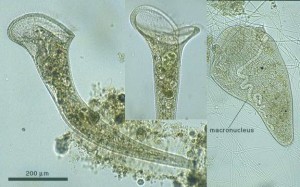Stentor
I’ve had the strangest illusionary experiences lately, almost mystical, occurring about two or three times a week.
Here’s one: I reached for a glass of water on the kitchen counter, and had a vivid memory of the apartment where I stayed in Asheville, North Carolina last year, during a speaking tour. And it was intense; I could remember almost every detail of the apartment, from décor to furnishings to the personality of my host.
That level of recall of someone else’s home is remarkable considering that Lori can change the art and other objects in our Vancouver apartment without my noticing for days. And nothing in my powerful Asheville recollection had anything to do with a glass of water.
Here’s another: I picked up a magazine from my nightstand, and flashed on an extremely detailed image of a one-celled organism that I had studied as an undergraduate student. The creature, Stentor, appeared in my mind as it looked under a microscope swimming in a dish of pond water. Although tiny, Stentor is a complex organism with many internal structures and external hairs and behaviors, all of which came back to me in exquisite detail during this mental impression.
And again, no obvious connection with what I was doing, or the magazine I was about to read.
Memory is known to work through associations, so that particular images are connected with information. For example, we see a face and we recall the person. But what is more curious is when memories are evoked by seemingly unassociated events.
Perhaps this flashback phenomenon, disconnected from its stimulus, is one of the pathways to creative writing, where imagination and inspiration interact to evoke and modify memories that can be woven together into story. The Canadian writer Robertson Davies described this process as: “Where the stuff comes from, what happens to it, how the unconscious and the conscious must be allowed to kiss and conmingle, and then how the conscious has to do the editing.”
Another conduit of creativity occurs when fully formed ideas leap into consciousness, seemingly from nowhere. When writing my recent book “Bee Time: Lessons From the Hive” I had just about completed a chapter about honey but couldn’t seem to find that last sentence.
I looked at the chapter almost daily for about a month without an ending emerging, until one day I woke up with these words in my head, fully formed: “Food at its best carries memories and reflections that go beyond sustenance to connect the personalities who harvest and the land from which they gather, making holy the simple act of eating.”
Random visions and the sudden arrival of fully formed sentences have one vital element in common: both serve the interests of storytelling. The Asheville apartment and the one-celled Stentor were images that held potential to evoke character and plot. These detailed memories were like freeze-framed scenes from a movie; all I had to do was press the play button and a story could unfold.
Our human brains are designed to mingle the conscious and the unconscious, and for the possibility of their fusion into language and story. I suspect all of us mingle dream images and consciousness, memory and observation, but perhaps it is the writer’s unique talent to unfreeze those frames and carry them forward into storytelling.
I don’t know if my brain flashes will continue to emerge into consciousness, or whether writing will flow from these snapshots. But they connect to stories from my past, and for that I treasure these occasional random eruptions of memory.
